El Metaverso en la Educación STEM: Evaluación interactiva con circuitos electrónicos y Arduino mediado por Inteligencia Artificial
The Metaverse in STEM Education: Interactive Assessment with Electronic Circuits and Arduino mediated by Artificial Intelligence
Óscar Bedoya-Cano
Universidad Pontificia Bolivariana, Colombia
José-Antonio Marín-Marín
Universidad de Granada
https://orcid.org/0000-0001-8623-4796
José-Jesús Sánchez-Amate
Universidad de Almería
https://orcid.org/0000-0003-0124-4579
Jesús López-Belmonte
Universidad de Granada
https://orcid.org/0000-0003-0823-3370
RESUMEN
Las teorías de aprendizaje que se fundamentan en la práctica y la experiencia se enriquecen con las nuevas formas de virtualidad, que abren un abanico de posibilidades pedagógicas en entornos digitales mediados por la inteligencia artificial. Estas teorías destacan la importancia de una comprensión efectiva de los fenómenos a través de la evidencia del aprendizaje, en donde la evaluación desempeña un rol esencial. En este contexto, la representación y simulación de procesos se convierten en recursos pedagógicos de gran valor, integrándose como elementos clave en los ejercicios de aula. Este artículo describe el desarrollo y aplicación de un conjunto de prácticas enfocadas en circuitos electrónicos utilizando la plataforma educativa de metaverso CoSpaces. La propuesta se presenta como una alternativa de evaluación práctica que explora el potencial de los entornos virtuales para fomentar el aprendizaje experiencial y la adquisición de competencias en electrónica, permitiendo que los estudiantes interactúen con circuitos simulados de manera inmersiva. Finalmente, se ofrecen diversas implicaciones teóricas y prácticas derivadas de este trabajo.
PALABRAS CLAVE
Metaverso; inteligencia artificial; evaluación; simulación; representación; circuitos eléctricos; Arduino; cospaces.
ABSTRACT
Learning theories that are based on practice and experience are enriched by new forms of virtuality, which open up a range of pedagogical possibilities in digital environments mediated by artificial intelligence. These theories highlight the importance of an effective understanding of phenomena through learning evidence, where assessment plays an essential role. In this context, the representation and simulation of processes become highly valuable pedagogical resources, integrated as key elements in classroom exercises. This article describes the development and application of a set of practices focused on electronic circuits using the CoSpaces metaverse educational platform. The proposal is presented as an alternative for practical assessment that explores the potential of virtual environments to promote experiential learning and the acquisition of electronics skills, allowing students to interact with simulated circuits in an immersive way. Finally, various theoretical and practical implications derived from this work are offered.
KEYWORDS
Metaverse; artificial intelligence; assessment; simulation; representation; electrical circuits; Arduino; cospaces.
1. INTRODUCTION
Metaverse and extended reality technology have emerged as a key tool for educational improvement, especially in the areas of science, technology, engineering, and mathematics (STEM) (Marín-Marín et al., 2021). These technologies offer immersive learning experiences, allowing students to simulate real-world scenarios. An innovative example is the implementation of electronic circuit practices in the metaverse, which combines simulation with modern assessment methodologies. By moving physical laboratory activities to a virtual environment, students interact with electronic components without the usual physical restrictions, enriching their learning experience (Lepez, 2022; Marrero Galván & Hernández Padrón, 2022).
This approach not only favors problem-based learning, but also allows the creation of virtual objects and spaces that enhance pedagogical interaction (López-Belmonte et al., 2022) and require teachers to innovate their practices (Aparicio Gómez et al., 2022). Specifically, by implementing exercises with electronic circuits based on the Arduino prototyping board (Marín-Marín et al., 2024) in a virtual environment, students experiment with simulations that replicate reality without the physical risks of a laboratory, promoting safer and more dynamic learning.
In this sense, immersive virtual environments have shown a direct relationship with increased student engagement and motivation (López-Belmonte et al., 2023). However, despite their initial benefits, research points to the need for a more in-depth evaluation of their impact at different educational levels. In particular, constructivist approaches and metacognitive strategies have been identified as fundamental to ensuring successful learning in these virtual environments (Bautista-Vallejo & Hernández-Carrera, 2020; Tigse-Carreño, 2019). In the STEM field, recent studies have shown that the metaverse not only improves student engagement and learning outcomes but also fosters collaboration and spatial skills development (Gülen et al., 2022; Sin et al., 2023; Solanes et al., 2023). Models such as Gamified Constructivist Teaching in the Metaverse (GCTM) offer promising results by improving interactions between students and teachers, personalizing learning, and allowing interactive presentation of projects (Ng et al., 2023). However, challenges persist, particularly in content development, accessibility, and teacher training (Dutta et al., 2022; Ortega Rodríguez, 2022).
As metaverse technologies continue to evolve, their transformative potential in education becomes more evident (López-Belmonte et al., 2023). These tools offer innovative solutions for both in-person and remote learning, providing students with unique opportunities to explore and experiment without the limitations of the physical world. However, it remains crucial to address challenges related to their implementation, such as interdisciplinary teacher training and consideration of ethical aspects in the use of the metaverse in education (Ortega Rodríguez, 2022).
In this context, the assessment of electronic circuit practices in the metaverse emerges as an innovative opportunity that combines immersive simulation with modern assessment approaches. This environment not only eliminates the physical limitations of traditional laboratories but also offers more dynamic and safer learning for students (López-Belmonte et al., 2022). The metaverse also promotes the active construction of knowledge through experimentation and simulation (Bartels & Hahne, 2023). This experience-based learning, proposed by authors such as Dewey (2004) or Piaget (1991), becomes especially relevant in this context, since students can manipulate real or simulated circuits, receiving immediate feedback. This feedback is key to adjusting and improving performance, aligning with the needs of STEM education (Zhang et al., 2024). On the other hand, problem-based learning approaches find in the metaverse a suitable space for students to face controlled practical situations, where the combination of electronic devices, programming, and simulation allows to effectively assess their ability to solve problems in real-life situations (Rudolphi-Solero et al., 2024). The integration of constructivism and problem-based learning in this environment enhances the representation of educational situations that simulate reality with a high level of effectiveness (Marín-Marín et al., 2020). Finally, an emerging solution for the evaluation of learning processes in immersive environments is the integration of artificial intelligence (AI). This integration has allowed students to receive real-time feedback, which optimizes learning and facilitates problem solving (Lévy & Zapata Ros, 2023). In addition, AI allows learning experiences to be personalized, adjusting tasks according to each student’s performance and fostering a dynamic educational environment, adapted to their individual needs (Wood & Malik, 2022).
2. STATE OF THE ART
2.1. Theories and pedagogical approaches underlying the immersive environments of the metaverse
The metaverse is a three-dimensional virtual world environment designed to foster social interaction between users, who can participate in activities that simulate real life. By integrating physical and virtual reality, the metaverse offers immersive experiences and multisensory interactions, allowing users to explore and participate in various scenarios. This scenario is ideal for developing various learning theories, such as Vygotsky’s constructivism and Ausubel’s theory of meaningful learning, which allow students to actively build their knowledge through experimentation and connect new learning with previous experiences (Bartels & Hahne, 2023). Furthermore, simulations allow working in environments where failure becomes an integral part of the learning process, allowing students to learn from their mistakes and continuously improve (Kaya et al., 2023). Virtual spaces, by their very nature, support these learning processes. Other theories, by authors such as John Dewey (Dewey, 2004), David Kolb (Kolb, 1984), and Jean Piaget (Piaget, 1991), focus on active and practical learning, where students acquire knowledge through direct interaction with their environment. In the context of electrical circuit practices, this pedagogical current allows students to experiment with real or simulated components, building and modifying circuits to observe in real time the consequences of their actions. The immediate feedback, characteristic of this approach, is key to adjusting and improving practices, promoting more dynamic and autonomous learning that aligns with the needs of STEM education (Zhang et al., 2024).
In complement to this practical approach, problem-based learning emerges as a key methodology within virtual environments (Jonassen & Hung, 2008; Jonassen, 2009). This methodology allows students to face controlled scenarios that simulate real-life situations, which is especially valuable in teaching electronic circuits. Through the combination of practical experimentation with technological problem solving, students’ ability to address everyday situations using electronic devices can be assessed (Rudolphi-Solero et al., 2024). The convergence of a problem situation, programming, and electronic devices allows constructivism and problem-based learning to be integrated, using virtual reality to simulate these scenarios and project their effectiveness.
2.2. Simulation and representation in STEM education
Visual representation in the metaverse facilitates the understanding of abstract concepts and allows for the virtual manipulation of complex electronic circuits. Simulations in these environments improve the quality of learning in technical disciplines (Cui, 2023) and in transdisciplinary works (Nicolescu, 1996), such as the STEM strategy (Kelley & Knowles, 2016; Tsupros et al., 2009). This computational representation process interprets reality in a way that optimizes learning and intensifies interaction, structuring and amplifying specific aspects to address educational barriers. This promotes a phenomenological approach, where the user’s experience and interaction with the simulated environment become the core of knowledge. The use of three-dimensional simulations has also been effective in teaching related topics, such as the perception of physical phenomena, incorporating by its nature the STEM areas (Gülen et al., 2022; Nagao, 2023; Tene et al., 2024), which is evident in the teaching of electronic circuits. This approach allows students to work with educational resources interactively, promoting a learning experience in which they can visualize the behavior of these resources in a dynamic and controlled environment. Simulation, both as a model and as a learning method (Duran, 2020; Singh-Pillay, 2024), facilitates a functional and practical interpretation of the world, which enriches its understanding and application in various areas. While computing acts as a platform for the development of these simulations, its precision and representation capacity continue to advance, integrating in ever greater detail characteristics of human interactions (Duo-Terrón et al., 2023; García-Tudela & Marín-Marin, 2022). Beyond reproducing physical elements, computational simulation seeks to characterize the various facets of human interaction, incorporating its nuances and complexities. In this context, any scenario, along with its elements and dynamics, becomes a target of computing to project and study the consequences of various actions within controlled environments, as is the case of the metaverse, which facilitates deeper and more contextual learning.
2.3. Assessment in virtual environments
Virtual platforms based on MOOCs have facilitated the creation of virtual laboratories where students can practice with simulations. The integration of the metaverse has improved students’ ability to work in teams and solve problems in technical disciplines (Liu & Lu, 2023), making it possible to measure parameters in the learning process from such platforms. Assessment frameworks based on measuring student performance in virtual environments (Tsappi et al., 2024; Zi & Cong, 2024; Zhu, 2024), tend to be increasingly comprehensive and holistic. This approach can be applied to the teaching of electronic circuits, where students could be assessed on their ability to assemble and solve problems through virtual objects. Even physical parameters such as the number of times a student blinks when faced with a situation (Barry et al., 2015), can provide relevant information to characterize their behavior when assessed in a metaverse environment (Beck et al., 2024). The use of artificial intelligence (AI) in assessment has allowed students to receive real-time feedback, adjusting the complexity of tasks based on their performance (Said, 2023). Similarly, there is an exploration of how AI can monitor student performance and provide personalized suggestions based on their progress (Liu et al., 2022) to enrich the learning environment in the metaverse.
AI’s ability to assess performance in real-time has been particularly useful in scenarios where students are assembling complex electronic circuits. NPCs (Non Player Characters) are effective in personalizing learning (Fadhel et al., 2024; Marín-Marín et al., 2023) and there is still discussion about how AI can be used to track learning and adjust tasks according to their needs in STEM areas (Solanes et al., 2023; Xu & Ouyang, 2022). In this scenario, the assessment stage of learning is enriched by the metaverse and the multiple possibilities it offers. The technological convergence of the digital age allows for much greater flexibility in the forms of representation and interaction with knowledge and its various actors, facilitating traceability, process adjustment, and measurement of its progress.
2.4. Building an evaluation environment for electrical circuits and Arduino
In the metaverse, the immersive experience allows for a more complete sensorial interaction than in two-dimensional virtual systems. In this sense, it is important that the level of detail of the elements (Wu & Hao, 2023; Zhang, 2023), both in their physical conformation and in their functional part, is similar to reality as proposed in digital twin systems (Siyaev & Jo, 2021; Wang et al., 2024). Now, for the design of an evaluative experience, the pedagogical component that aims to develop competencies in students through practical exercises must consider both collaboration (Birkeland et al., 2023) and successful interaction with the learning object, as well as the consequences of errors in the event of failure.
The theory of electronic circuits is based on physical behavior which is replicable virtually with a mathematical model (Jain & Soni, 2024); Due to the characteristics of current, voltage, and electrical resistance, among other devices, the laboratory practice for circuits requires essential care to not exceed current levels that can cause damage to the electronic elements, and with some probability of fire risk and physical harm to the student. From there, providing a controlled space that demonstrates the operating principles of technologies based on these elements is an alternative (Jaakkola & Veermans, 2020) which, from a pedagogical point of view, poses new challenges at various times: the structuring of the practice, the execution, and the form of evaluation.
In the physical scenario, a student who makes a mistake in an electrical circuit faces two possibilities: The first, the circuit does not work correctly because the elements are not interconnected or programmed correctly, and the second, as a consequence of the first, the elements will not work in any case since, due to the bad connection, they suffer permanent damage. This situation that causes demotivation in the student can be addressed with virtual reality elements (Reeves & Crippen, 2021; Tarng et al., 2024), making more efficient use of the time invested in the search for the causes that cause the malfunction of the circuits in practice.
The evaluative proposal in the metaverse of this article contemplates the connectivity of test elements from the use of the Protoboard, and its scope, which reaches the connection of the Arduino programmable device with simple sensors (López-Belmonte et al., 2020). The design proposal in the circuit evaluation scenarios is addressed from two stages: the representation stage, and the simulation stage.
2.5. Representation stage
The construction of virtual objects can be proposed from 3D modeling exercises, in platforms such as Blender, Maya3d, Solidworks, among others. This virtual object design module is complementary from a didactic perspective, since students can build virtual objects that will later be exported to a metaverse scenario with interoperable formats such as. fbx,. obj,. gltf files, or in virtual spaces that support scenario formats compatible with USD (Universal Scene Description) standards. In addition, there is also a large number of virtual objects on offer in 3D stores, such as Sketchfab, Turbosquid, Cgtrader (Figure 1).
Figure 1. Virtual Item Stores.
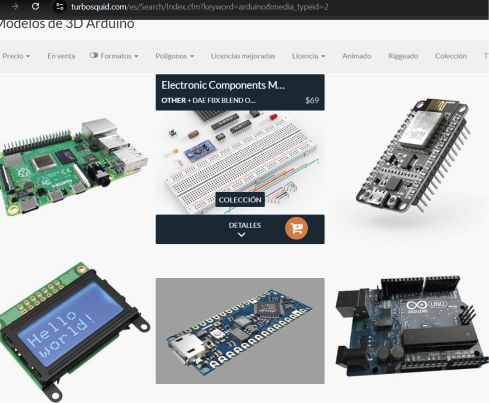
Note. Taken from https://www.turbosquid.com/es/Search/Index.cfm?keyword=arduino&media_typeid=2
The preliminary step is the construction of the virtual object. Initially, the main interest is focused on the detail of its physical appearance, preserving the dimensional proportions, and the characteristics to be represented (Figure 2). From there, learning activities specific to the construction and design of the object can be derived, in which the students (or teachers) themselves are the ones who build their learning objects.
Figure 2. Arduino representation in Blender software.
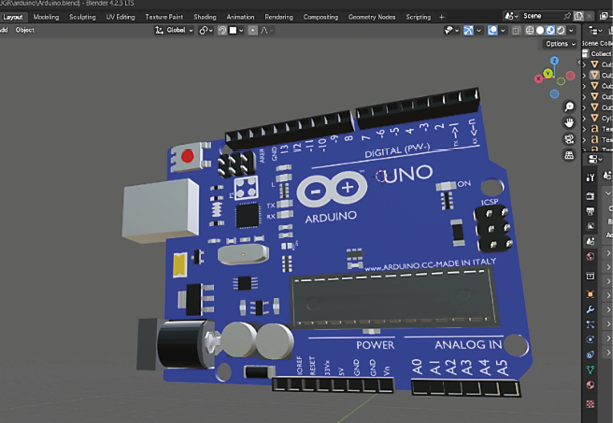
Note. Arduino board construction stage in Blender Software.
It is important to have the dimensions of all objects in parallel, viewing them together, or independently so that when importing each element into the metaverse space, it does not suffer unwanted or disproportionate scaling on the various axes (Figure 3).
Figure 3. Representation of Arduino board, electronic devices and breadboard.
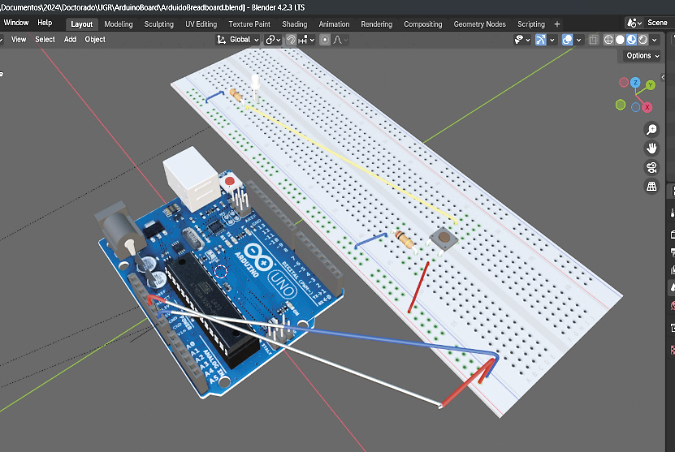
Note: Assembly of electronic elements, wiring and basic connectivity of three-dimensional models.
2.6. Simulation stage
To emulate the functional and logical behavior of the elements, it is necessary to build an interactive three-dimensional scenario, or to use spaces that provide the same functionality. For this case, platforms such as Unity, Omniverse, Godot, Unreal Engine or Cospaces can be used. From there, the one that allows, through blocks or scripts, the programming of the elements before the user interaction in the metaverse is selected (Figure 4); for the present exercise, Cospaces is selected due to its versatility to use both scripts in Python language, as well as block programming. The sequence of activities is as follows: in the first exercise, students recognize the test board and its connections; a second exercise recognizes the connection of the resistors and Ohm’s law for the amount of current needed before breaking down the elements; the third exercise aims to recognize the connection of the circuit; and finally, the fourth exercise shows the proximity sensor based on ultrasound and its block programming.
Figure 4. Block programming in the cospaces metaverse.
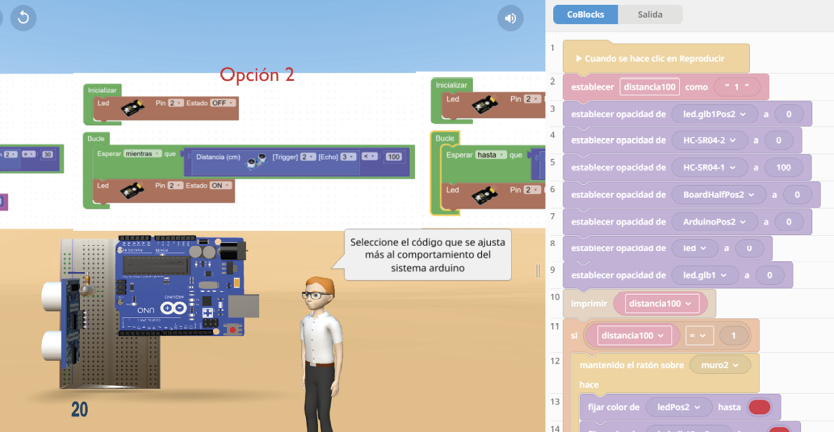
Note. Taken from https://edu.cospaces.io/Studio/Space/Vlxx5yB59WmUIT7M
The first exercise provides a scenario in which the breadboard is the main learning object (Figure 5). Understanding the connection methods is the main objective for this learning; for this, 3 different connectivity options are used and the correct way in which there is conductivity to the LED (Light Emitting Diode) is asked, so that it lights up. The student can see if there is a connection by touching two points on the breadboard, which will light up if there is conductivity between the two points, while in exercise 2, emphasis is placed on the maximum current levels allowed before an element does not work. There, Ohm’s law and its implementation are described and practically executed. By showing the voltage and current limits when selecting the wrong resistance value, the current through the LED will exceed the maximum allowed value, which will cause its breakdown (Figure 6).
Figure 5. Practice 1 breadboard and connections.
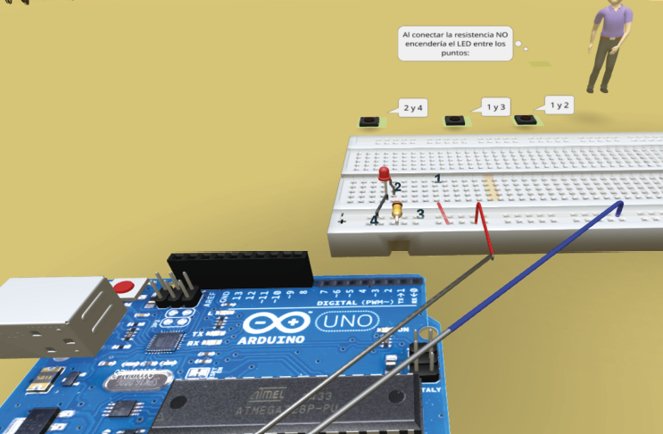
Note. Connectivity in the CoSpaces Educational Metaverse.
Figure 6. Practice 2. Ohm’s law and maximum current.
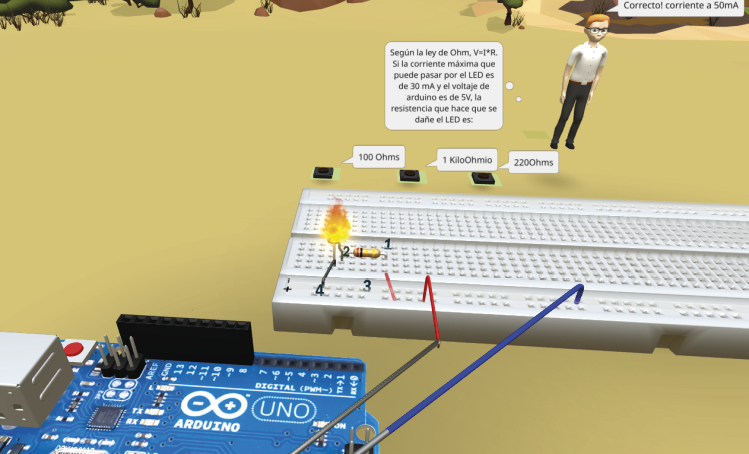
Note. CoSpaces Educational Metaverse. https://edu.cospaces.io/Studio/Space/sVenBDKsoxcOSnnX
The third scenario allows to interact with the connections on a proximity sensor using ultrasound (Figure 7). In this practice, the type of connection must be compared, by carefully examining the diagram, with the virtual connection. The functional graph allows to compare whether the system’s operation corresponds to the physical connections, making the operation of the circuit possible. The fourth scenario comprises the programming logic with the necessary parameters according to the described scene. The distance of the sensor from the obstacle and the necessary programming blocks that define its behavior are illustrated in the scene inside the metaverse (Figure 8).
Figure 7. Practice 3. Ultrasonic sensor connection diagram.
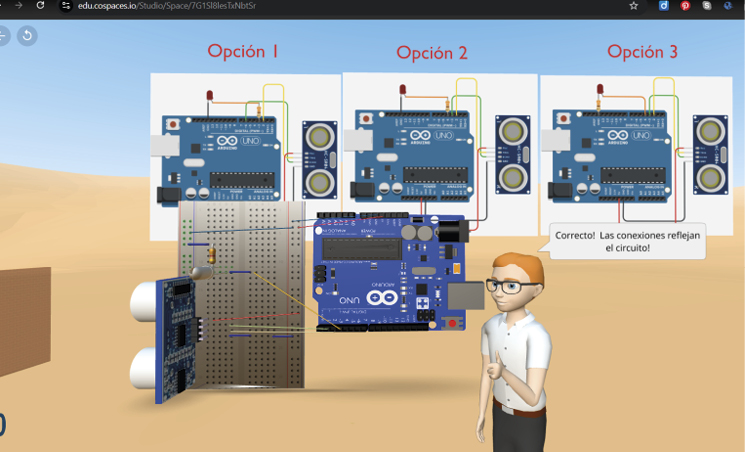
Note. Educational Metaverse in CoSpaces. https://edu.cospaces.io/Studio/Space/7G1Sl8lesTxNbtSr
Figure 8. Practice 4. Block diagram and connection of ultrasound sensor.
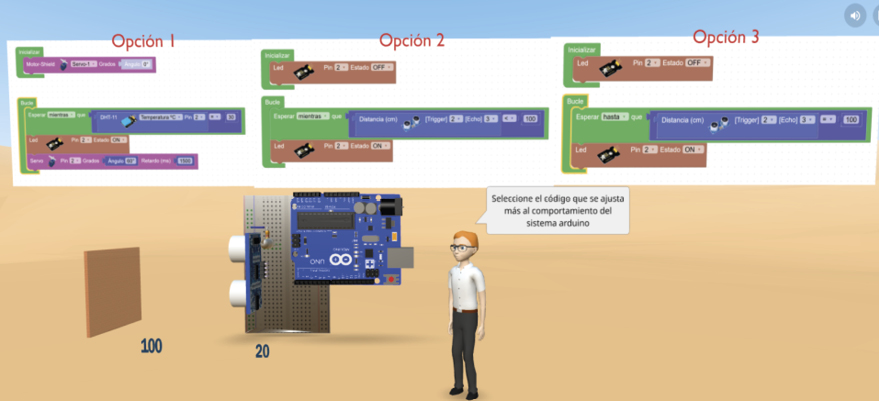
Note. Educational Metaverse in CoSpaces. https://edu.cospaces.io/Studio/Space/Vlxx5yB59WmUIT7M
2.7. Mediation of artificial intelligence in educational practice
The integration of AI into the metaverse for STEM education opens up new possibilities for creating personalized, adaptive, and interactive experiences that enhance learning and assessment processes. As a mediator, AI acts on three main levels: personalization of learning, dynamic assessment, and facilitation of interaction with immersive environments (Dúo-Terrón et al., 2023).
AI can analyze student interaction data in real time to adapt educational content in the metaverse to their specific needs (Aparicio, 2023). This includes identifying gaps in prior knowledge, optimizing task difficulty, and proposing personalized learning paths. In an electronic circuits and Arduino context, AI can recommend specific simulations or building guides based on the student’s skill level and performance in previous activities (González-González & Silveira-Bonilla, 2022).
Likewise, AI powers formative and summative assessment by collecting, analyzing, and reporting student performance metrics in metaverse environments (García-Peñalvo et al., 2024). In the creation and simulation of electronic circuits with Arduino, AI can measure accuracy, design efficiency, and compliance with learning objectives, generating immediate feedback. Additionally, advanced algorithms can identify common error patterns and provide specific explanations, promoting a deeper understanding of STEM concepts (Sanabria-Navarro et al., 2023).
In addition, AI enables fluid interactions in the metaverse by managing virtual agents or intelligent assistants. These agents can guide students in hands-on activities, answer questions, or even evaluate their performance by analyzing actions and commands in real time. In an Arduino virtual lab, an AI-powered virtual assistant can verify simulated electronic connections, suggest improvements, and evaluate entire projects based on predetermined criteria (Forero-Corba et al., 2024). Similarly, the use of AI as a mediator in STEM education within the metaverse not only improves the effectiveness of learning but also creates a bridge between theoretical content and its practical application. When integrated into interactive platforms, AI ensures that the student experience is inclusive, effective, and aligned with assessment objectives, allowing for a more robust development of competencies in areas such as electronic engineering, programming, and critical thinking (Moral-Sánchez et al., 2023).
3. CONCLUSION
Electronic circuit practice assessment in the metaverse combines advanced simulation capability with interactive learning methodologies. Immersive technologies and virtual platforms offer students unique opportunities to learn and be assessed in an environment that simulates reality. Furthermore, the integration of AI in assessment ensures that students receive real-time feedback, optimizing their learning and problem-solving process.
AI plays a key role as a mediator in the assessment process within the metaverse, by facilitating the personalization of learning. AI algorithms not only detect common student failures but also generate new educational challenges tailored to the individual needs of each participant. This fosters dynamic and adaptive learning, promoting a deeper understanding of technical concepts and enhancing the development of key STEM competencies.
Furthermore, AI-powered virtual assistants enrich the educational experience by acting as real-time guides, interactive evaluators, and sources of instant feedback. In the context of electronic circuits practice, AI can assess circuit design, verify simulated connections, and provide suggestions for improvement, allowing students to experiment with greater confidence and security. These capabilities reinforce problem-based learning by offering an environment where students can make mistakes, analyze them, and learn from them without material repercussions.
The metaverse as an educational environment not only empowers hands-on electronic circuits learning, but when integrated with AI, it enables a more inclusive and collaborative approach. AI facilitates the connection between students and instructors from different parts of the world, creating global learning opportunities that democratize access to knowledge. Furthermore, its ability to analyze large-scale performance data continuously improves educational methodologies, ensuring that virtual environments evolve along with the needs of students and industry.
Therefore, the integration of artificial intelligence in the metaverse transforms electronic circuits practice into an interactive, personalized, and collaborative educational experience. This not only fosters the development of technical and creative skills, but also prepares students to face the challenges of an increasingly technology-driven world, consolidating the metaverse as a key tool in the STEM education of the future.
4. PROSPECTIVE
4.1. Theoretical implications
Theoretically, this work suggests that the metaverse can be conceptualized not only as a simulation tool, but as a new educational paradigm. This model redefines the idea of a “classroom” by allowing students to interact with a realistic environment without the physical limitations of a traditional laboratory. From a theoretical perspective, it can be argued that the metaverse expands the scope of the constructivist theory of learning, where students “learn by doing” in environments that mimic real situations.
This work contributes to the theory of formative assessment by proposing an approach in which AI acts as a facilitator of real-time feedback and personalization of learning. This feature adds a theoretical dimension to the use of technology in education, proposing a framework in which assessment not only measures performance, but also adapts the learning experience to the individual progress of the student.
The inclusion of the metaverse in the practice of electronic circuits and the use of tools such as Arduino suggest that learning in virtual environments is not only effective for the acquisition of technical knowledge, but also for the development of metacognitive and collaborative skills. From a theoretical perspective, this can contribute to the field of digital pedagogy, highlighting the importance of virtual education in preparing students for the digital economy and its demands for both technical and soft skills.
Finally, this work suggests a democratization of knowledge through remote access to highly specialized learning environments, such as virtual laboratories. This has theoretical implications in the field of equity in education, suggesting that the metaverse can reduce geographical and economic barriers, and serve as a model for future inclusive and accessible learning environments.
4.2. Practical Implications
At a practical level, this work implies that educational institutions can design curricula that integrate simulation practices in the metaverse for teaching electronic circuits. This allows students to learn in a flexible and autonomous way, performing practices that would traditionally require access to a physical laboratory. In addition, it can allow students to learn with a more self-directed and autonomous approach, adapted to their own pace.
The proposed real-time assessment practices can transform traditional feedback methods in technical practices. Instructors and educational program developers can employ AI to monitor and analyze student progress, adjusting content or challenges based on each student’s performance. This practice improves educational efficiency by reducing the time between error and correction and facilitates deeper learning.
The possibility of performing virtual experiments without the risk of accidents or wear and tear on expensive components has clear practical benefits. Institutions can optimize their resources by reducing the need for physical equipment, while students acquire problem-solving skills in environments without material consequences. This is especially relevant in contexts where resources for physical materials are limited or expensive.
The possibility of collaborative practices in the metaverse allows students and teachers from different parts of the world to work together in real time. This means that educational programs can be designed to include teamwork with an international dimension, strengthening intercultural collaboration skills that are increasingly relevant in the global labor market.
Ultimately, from a practical perspective, this work supports the development of applied digital skills. By using tools such as Arduino in a virtual environment, students not only learn electronics concepts, but also develop advanced digital skills. This prepares them for work environments that increasingly rely on advanced technologies and process virtualization, essential skills for emerging industries in the digital economy.
FUNDING
FABLAB IN EDUCATION: A training and practical proposal for the creation of teaching resources aimed at university teaching staff (PID-20-85).
REFERENCES
, , & (2022). La convergencia de aprendizajes en el metaverso. Revista Interamericana de Investigación Educación y Pedagogía RIIEP, 15(2), 385–398. https://doi.org/10.15332/25005421.7879
(2023). La inteligencia artificial y su incidencia en la educación: Transformando el aprendizaje para el siglo XXI. Revista internacional de pedagogía e innovación educativa, 3(2), 217-230. https://doi.org/10.51660/ripie.v3i2.133
, , , , , , , & (2015). Evaluation for Students’ Learning Manner Using Eye Blinking System in Metaverse. Knowledge-Based and Intelligent Information & Engineering Systems 19th Annual Conference, KES-2015, Singapore, September 2015 Proceedings, 60, 1195-1204. https://doi.org/10.1016/j.procs.2015.08.181
, & (2023). Teaching Building Information Modeling in the Metaverse—An Approach Based on Quantitative and Qualitative Evaluation of the Students Perspective. Buildings, 13(9). https://doi.org/10.3390/buildings13092198
, & (2020). Aprendizaje basado en el modelo STEM y la clave de la metacognición. Innoeduca International Journal of Technology and Educational Innovation, 6(1), 14–25. https://doi.org/10.24310/innoeduca.2020.v6i1.6719
, , & (2024). Educational Practices and Strategies With Immersive Learning Environments: Mapping of Reviews for Using the Metaverse. IEEE Transactions on Learning Technologies, 17, 319-341. https://doi.org/10.1109/TLT.2023.3243946
, , & (2023). Understanding Collaboration in Virtual Labs: A Learning Analytics Framework Development (pp. 192-203). https://doi.org/10.1007/978-3-031-26876-2_18
(2023). Analysis and Quality Improvement Research of MOOC. Proceedings of the 6th International Conference on Digital Technology in Education, 193-199. https://doi.org/10.1145/3568739.3568772
(2004). Experiencia y Educación. Biblioteca Nueva.
, , , & (2023). Inteligencia Artificial y Machine Learning como recurso educativo desde la perspectiva de docentes en distintas etapas educativas no universitarias. Revista Interuniversitaria de Investigación En Tecnología Educativa, 58–78. https://doi.org/10.6018/riite.579611
(2020). What is a Simulation Model? Minds And Machines, 30(3), 301-323. https://doi.org/10.1007/s11023-020-09520-z
, , , , , , & (2022). Challenges in metaverse in problem-based learning as a game-changing virtual-physical environment for personalized content development. 6th Smart Cities Symposium (SCS 2022), 417–421.
, , , , , , , , , , , & (2024). Navigating the metaverse: Unraveling the impact of artificial intelligence—A comprehensive review and gap analysis. Artificial Intelligence Review, 57(10), 264. https://doi.org/10.1007/s10462-024-10881-5
, & (2024). Técnicas y aplicaciones del Machine Learning e Inteligencia Artificial en educación: una revisión sistemática. RIED-Revista Iberoamericana De Educación a Distancia, 27(1), 1-34. https://doi.org/10.5944/ried.27.1.37491
, , & (2024). La nueva realidad de la educación ante los avances de la inteligencia artificial generativa. RIED-Revista Iberoamericana de Educación a Distancia, 27(1), 9-39. https://doi.org/10.5944/ried.27.1.37716
, & (2023). Use of Arduino in primary education: A systematic review. Education Sciences, 13(2), 134. https://doi.org/10.3390/educsci13020134
, & (2022). Educación e Inteligencia Artificial: Nodos temáticos de inmersión. Edutec, Revista Electrónica De Tecnología Educativa, (82), 59–77. https://doi.org/10.21556/edutec.2022.82.2633
, , & (2022). STEM Education in Metaverse Environment: Challenges and Opportunities. Journal of STEAM Education, 5(2), 100-103. https://doi.org/10.55290/steam.1139543
, & (2020). Learning electric circuit principles in a simulation environment with a single representation versus “concreteness fading” through multiple representations. Computers & Education, 148, 103811. https://doi.org/10.1016/j.compedu.2020.103811
, & (2024). Virtual Reality in Electronics and Communication Engineering Education. 2024 IEEE International Conference on Information Technology, Electronics and Intelligent Communication Systems (ICITEICS), 1-5. http://dx.doi.org/10.1109/ICITEICS61368.2024.10624857
(2009). Learning to solve problems: an instructional design guide. Gifted and Talented International, 24(2), 153-154. http://dx.doi.org/10.1080/15332276.2009.11673538
, & (2008). All Problems are Not Equal: Implications for Problem-Based Learning. Interdisciplinary Journal of Problem-based Learning, 2. https://doi.org/10.7771/1541-5015.1080
, , & (2023). Transforming Education with Augmented Reality, Metaverse and Virtual Reality Technologies in the 21st Century. Hacettepe University Journal of Education, 34, 470-497. https://doi.org/10.16986/HUJE.2023.503
, & (2016). A Conceptual Framework for Integrated STEM Education. International Journal of STEM Education, 3(11), 1-11. https://doi.org/10.1186/s40594-016-0046-z
(1984). Experiencial Learning. Prentice Hall.
(2022). Metaverse and education: a panoramic review. Metaverse Basic and Applied Research, 1, 2. https://doi.org/10.56294/mr20222
, & (2023). Visiones de espacios de trabajo tridimensionales o virtuales, metaversos, y educación. Realidad virtual y aprendizaje: Presentación del número especial y conclusiones. RED, 23(73). https://doi.org/10.6018/red.554591
, , , , , & (2022). A Metaverse-based Student’s Spatiotemporal Digital Profile for Representing Learning Situation (p. 8). https://doi.org/10.23919/iLRN55037.2022.9815985
& (2023). A Study on the Application of Metaverse in Vocational Education. 2023 13th International Conference on Information Technology in Medicine and Education (ITME), 385-392. https://doi.org/10.1109/ITME60234.2023.00083
, , , & (2020). Arduino Advances in Web of Science. A Scientific Mapping of Literary Production. IEEE Access, 8,128674-128682. https://doi.org/10.1109/ACCESS.2020.3008572
, , , & (2022). Flipped Learning and E-Learning as Training Models Focused on the Metaverse. Emerging Science Journal, 6, 188-198. https://doi.org/10.28991/ESJ-2022-SIED-013
, , , & (2022). Design and validation of a questionnaire for the evaluation of educational experiences in the metaverse in Spanish students (METAEDU). Heliyon, 8(11), 1-13. https://doi.org/10.1016/j.heliyon.2022.e11364
, , , & (2023). Metaverso en Educación: una revisión sistemática. Revista de Educación a Distancia (RED), 23(73), 1-25. http://dx.doi.org/10.6018/red.511421
, , , & (2023). We’ve reached the GOAL. Teaching Methodology for Transforming Learning in the METAVERSE. A teaching innovation project. Metaverse Basic and Applied Research, 2, 30. https://doi.org/10.56294/mr202330
, , & (2024). Computational thinking and programming with Arduino in education: A systematic review for secondary education. Heliyon, 10(8), e29177. https://doi.org/10.1016/j.heliyon.2024.e29177
, , , & (2023). Attitudes towards the development of good practices with augmented reality in secondary education teachers in Spain. Technology Knowledge and Learning, 28(4), 1443–1459. https://doi.org/10.1007/s10758-023-09671-9
, , , & (2021). STEAM in education: a bibliometric analysis of performance and co-words in Web of Science. International Journal of STEM Education, 8(1). https://doi.org/10.1186/s40594-021-00296-x
, , , & (2020). Makey Makey as an Interactive Robotic Tool for High School Students’ Learning in Multicultural Contexts. Education Sciences, 10, 1-14. https://doi.org/10.3390/educsci10090239
, & (2022). La trascendencia de la realidad virtual en la educación STEM: una revisión sistemática desde el punto de vista de la experimentación en el aula. Bordón Revista de Pedagogía, 74(4), 45–63. https://doi.org/10.13042/bordon.2022.94179
, , & (2023). Analysis of artificial intelligence chatbots and satisfaction for learning in mathematics education. IJERI: International Journal of Educational Research and Innovation, (20), 1–14. https://doi.org/10.46661/ijeri.8196
(2023). Virtual Reality Campuses as New Educational Metaverses. IEICE Transactions on Information and Systems, E106.D, 93-100. https://doi.org/10.1587/transinf.2022ETI0001
, , , , , , , & (2023). From classroom to metaverse: A study on gamified constructivist teaching in higher education. In Lecture Notes in Computer Science (pp. 92–106). Springer Nature Singapore.
(1996). La Transdisciplinariedad Manifiesto. Ediciones Du Rocher. https://www.ceuarkos.edu.mx/wp-content/uploads/2019/10/manifiesto.pdf
(2022). De la Realidad Extendida al Metaverso: una reflexión crítica sobre las aportaciones a la educación. Teoría de La Educación Revista Interuniversitaria, 34(2), 189–208. https://doi.org/10.14201/teri.27864
(1991). Seis estudios de Psicología. Labor.
, & (2021). Virtual Laboratories in Undergraduate Science and Engineering Courses: A Systematic Review, 2009-2019. Journal of Science Education and Technology, 30(1), 16-30. https://doi.org/10.1007/s10956-020-09866-0
, , , , & (2024). An Interuniversity Competition for Medical Students to Learn Radiology in the Second Life Metaverse. Focus on Interventional Radiology, 21(5), 812-821. https://doi.org/10.1016/j.jacr.2023.09.012
(2023). Metaverse-Based Learning Opportunities and Challenges: A Phenomenological Metaverse Human–Computer Interaction Study. Electronics, 12(6). https://doi.org/10.3390/electronics12061379
, , , & (2023). Incidences of artificial intelligence in contemporary education. Comunicar, 77, 97-107. https://doi.org/10.3916/C77-2023-08
, , , , , , , , , & (2023). Toward an Edu-metaverse of knowledge: Immersive exploration of university courses. IEEE Transactions on Learning Technologies, 16(6), 1096–1110. https://doi.org/10.1109/tlt.2023.3290814
(2024). Exploring Science and Technology Teachers’ Experiences with Integrating Simulation-Based Learning. Education Sciences, 14(8). https://doi.org/10.3390/educsci14080803
, & (2021). Towards Aircraft Maintenance Metaverse Using Speech Interactions with Virtual Objects in Mixed Reality. Sensors, 21(6). https://doi.org/10.3390/s21062066
, , , , , & (2023). Enhancing STEM education through interactive metaverses: A case study and methodological framework. Applied Sciences (Basel, Switzerland), 13(19), 10785. https://doi.org/10.3390/app131910785
, , , , , & (2023). Enhancing STEM Education through Interactive Metaverses: A Case Study and Methodological Framework. Applied Sciences, 13(19), 1-17. https://doi.org/10.3390/app131910785
, , , , , , & (2024). Development of a virtual teaching module for advanced semiconductor fabrication and its learning effectiveness analysis. Computer Applications in Engineering Education. https://doi.org/10.1002/cae.22802
, , , , , & (2024). Integrating immersive technologies with STEM education: A systematic review. Frontiers in Education, 9. https://doi.org/10.3389/feduc.2024.1410163
(2019). El Constructivismo, según bases teóricas de César Coll. Revista Andina de Educación, 2(1), 25–28. https://doi.org/10.32719/26312816.2019.2.1.4
, , & (2024). Developing a Performance Evaluation Framework Structural Model for Educational Metaverse. Technologies, 12(4). https://doi.org/10.3390/technologies12040053
, , & (2009). STEM Education: A project to identify the missing components [Summary report]. The Intermediate Unit 1: Center for STEM Education and Leonard Gelfand Center for Service Learning and Outreach at Carnegie Mellon University, Pennsylvania. https://www.cmu.edu/gelfand/archive/archived-documents/stem-survey-report-cmu-iu1.pdf
, , & (2024). Digital Twin Technology of Metaverse Based on Game Engine in the Campus Application Scenarios. Academic Journal of Engineering and Technology Science, 7(2), 157-163. https://doi.org/10.25236/AJETS.2024.070223.
, & (2022). A landscape review of the literature focusing upon the use of technology to support problem, case and project based learning in higher education STEM disciplines. Towards a New Future in Engineering Education, New Scenarios That European Alliances of Tech Universities Open Up, 872–889.
, & (2023). Edu-Metaverse: concept, architecture, and applications. Interactive Learning Environments, 32(8), 4352–4379. https://doi.org/10.1080/10494820.2023.2198567
, & (2022). The application of AI technologies in STEM education: A systematic review from 2011 to 2021. International Journal of STEM Education, 9(1), 59. https://doi.org/10.1186/s40594-022-00377-5
(2023). Metaverse Applications for Construction of Educational Digital Resources. Metaverse – METAVERSE 2023: 19th International Conference, Held as Part of the Services Conference Federation, SCF 2023, Honolulu, HI, USA, September 23–26, 2023, Proceedings, 108-119. https://doi.org/10.1007/978-3-031-44754-9_9
, , , , V., Benes, B., & Magana, A. J. (2024). Virtual and Augmented Reality in Science, Technology, Engineering, and Mathematics (STEM) Education: An Umbrella Review. Information, 15(9). https://doi.org/10.3390/info15090515
(2024). Introducing immersive virtual reality in a marketing practical training course: Qualitative evaluation with undergraduates. The International Journal of Management Education, 22(3), 101058. https://doi.org/10.1016/j.ijme.2024.101058
, & (2024). Metaverse Solutions for Educational Evaluation. Electronics, 13(6). https://doi.org/10.3390/electronics13061017